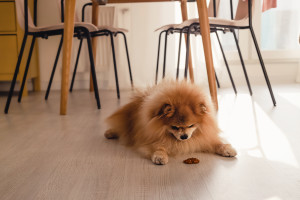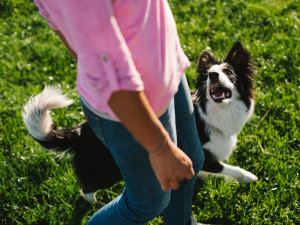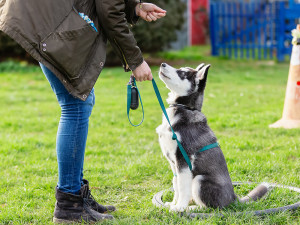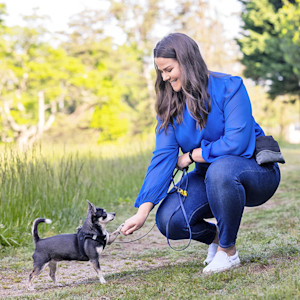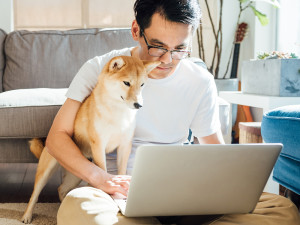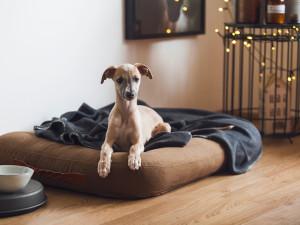How to Teach Your Dog to Roll Over in 4 Simple Steps
Get them doing tricks in no time with our guide.
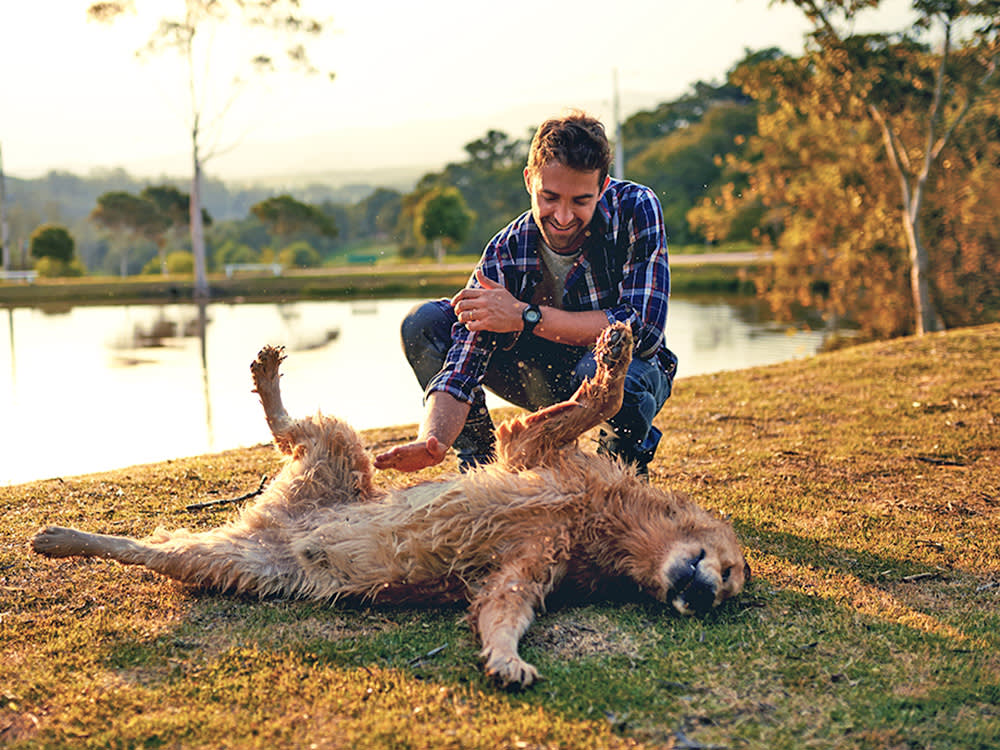
Share Article
In This Article:
Understanding the Basics of Dog Trainingopens in a new tab Training Tipsopens in a new tab
Did you know dogs can understand over 160 words and gestures? They’re smarter than we sometimes give them credit for. Training them to do tricks taps into their instincts and intelligence. Teaching your dog to roll over is a fun, rewarding experience, whether you’ve got a sprightly, springy pup or an older dog learning new tricksopens in a new tab.
But teaching your dog to roll over is also about more than tricks. It’s about when your dog looks at you with the “I got this!” gleam in their eyes. It’s about bonding, building trust, and sharing a few laughs when they accidentally turn their first-time roll into a wiggly belly flop.

littleKin™ is Kinship’s home just for puppy and kitten parents. Bop over to check out expert advice, new pet tools, and special deals—all curated for your newest family member.
opens in a new tabCan your pup pull off the classic “roll over” move? Absolutely, with time, patience, enthusiasm, and encouragement. Here’s a breakdown of how to teach your dog to roll over in four simple steps.
Understanding the basics of dog training
According to Alisha Kidwell, a veterinarian in North Carolina, “Consistency and positivity are must-haves in creating a strong foundation for training.”
Dog training is like teaching toddlers their ABCs: It requires patience, repetition, and encouragement. Keep your training sessions short (five to 10 minutes). Choose a distraction-free space where your dog can focus. Timing is everything. Try training your dogopens in a new tab when your pup is relaxed but alert, not when they’re “bouncing off the walls” with energy or needing a nap.
Equally important is using clear, consistent commands and positive reinforcement, such as treats, praise, and their favorite toys. Dogs thrive on routines, patterns, and schedules, so sticking to the same verbal cues, hand signals, and timing will help associate your requests with actions. If you mix up words or gestures, you may confuse your pup, making progress slower and more frustrating for both of you.
Step-by-step guide to teaching roll over
1. Have them “lie down”
The foundation for rolling over is the “lie down” command. Your dog must master lying on their belly before fully rolling over.
Hold a treat and slowly lower your hand to the ground, holding your dog’s attention while saying, “Lie down.” The command should be clear and firm but positive. Their nose will follow the treat, naturally sinking into position. Once their belly touches the floor, shower them with praise and a treat.
Show them love and don’t rush into another trick. Praise and positive reinforcement will build their confidence.
2. Have them “move to their side”
Once your dog is lying down, it’s time to introduce the side roll. Use a treat again to guide their nose toward their shoulder. Their head will follow, causing their body to shift to the side. When they complete the move, give them a treat and encouragement.
This step helps them feel more comfortable with a rolling motion.
3. Teach “roll over”
Now for the finale: the roll.
With your dog lying on their side, hold the treat near their nose and slowly guide it in an arc over their body. Their head, torso, and hips will naturally follow. Voila! Your pup has rolled over successfully. Celebrate with treats, pets, praise, and excitement.
4. Keep practicing
Repetition is the secret to successful dog trainingopens in a new tab. Practice the roll-over trick several times daily; keep sessions short to avoid overwhelming your dog. Introduce verbal cues like “roll over” as they get the hang of it. Gradually reduce your reliance on treats once they’ve mastered the move.
Training tips
Read your dog.
Like people, dogs have good and bad days. Some days, pups are more open to learning; other days, they prefer to be left alone.
Pay attention to their body language — if their tail wags and their eyes are bright, they’re in a good mood and ready to learn. If they seem bored, grumpy, or distracted, call it quits for now.
Show your dog a good time.
Training shouldn’t feel like a chore for you or your pup — it should be a fun bonding experience. Keep the energy light-hearted and positive by using an enthusiastic, encouraging tone, praise, and playful interactions.
If your dog associates training with enjoyment, they’ll look forward to sessions with excitement and a willingness to learn. Incorporate play and rest breaks to keep their spirits high, especially if your dog is starting to lose focus.
A happy dog learns faster and retains more, making the process smoother and more enjoyable.
Use treats.
Treats are the ultimate motivator for most dogs. Choose high-value snacks they usually don’t get, like small pieces of rotisserie chicken, cheese cubes, or specialized training sausages. Treats should be small enough to avoid overfeeding but enticing (and delicious) enough to hold their full attention.
Avoid frustration.
Dogs can sense your emotions, so avoid training if you’re having a bad day. Impatience, annoyance, or anxiety can derail their progress. Training should be a positive experience, so focus on celebrating small victories. Patience and a calm demeanor will help build trust and confidence.
Break things down simply.
When teaching your dog new tricksopens in a new tab, think of small steps, not giant leaps. Break the trick into manageable pieces and work one step at a time.
For example, if your dog struggles to complete a side roll, focus on building their confidence to encourage a full roll. Build up to the entire motion with positive reinforcements for steps they complete, like lying down.
End practice on a happy note.
How you end one training session will set the tone for the next. Always finish on a positive note. Pat your pup on the head and make them feel accomplished with praise and a treat. This will get them excited for the next round of training. The goal is to associate training with positivity and fun.
References
Udell, Monique A. R., and Clive D. L. Wynne. “Dog Rolling Behavior.” Psychology Department, University of Wisconsin–Stevens Point, https://www4.uwsp.edu/psych/dog/la/drp12.htmopens in a new tab

Valerie Mellema
Valerie Mellema has a Bachelor of Science in Agribusiness and Equine Industry from West Texas A&M University. She has been a professional writer for the past 20 years, covering a wide variety of pet health and care topics before founding a nonprofit focused on mental health in children and thoroughbred aftercare. She has four Border Collies and eight retired racehorses.
Related articles
![A dog walking in the grass alongside a dog trainer.]() opens in a new tab
opens in a new tabHow to Become a Dog Trainer
This guide will help you turn your dog training passion into a profession.
![Woman trains with a young husky on a dog training field]() opens in a new tab
opens in a new tabHow to Find a Qualified Trainer for Your New Dog
The questions to ask and credentials to look out for to find the right trainer for your dog, according to a pro.
![Juliana DeWillems, KPA CTP, is a member of the Karen Pryor Academy faculty.]() opens in a new tab
opens in a new tab10 Dog-Training Instagram Accounts You’ll Love as Much as Dogs Love Squirrels
The answer to your obedience questions—right there on your phone.
![A dark-haired man using a laptop to train his Shiba Inu online]() opens in a new tab
opens in a new tabHow Online Training Supports Dog Owners and Dog Trainers
The virtual dog-training revolution is here.
![Greyhound puppy sitting on her bed on the bedroom floor]() opens in a new tab
opens in a new tabUse Platform Dog Training to Elevate Your Pup’s Skills
Using platforms are favorites with pro dog trainers—here’s why you should add them to your training to-do list.
![A red haired woman dog trainer kneeling in front of a Shepherd mixed breed dog with one finger raised that the dog is looking at in an outdoor training course.]() opens in a new tab
opens in a new tabUnderstanding Popular Dog Training Methods
Look behind the advertising language when picking a dog trainer.
